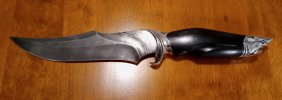- Joined
- Jul 24, 2022
- Messages
- 89
You got that link or some key words to use? Having trouble finding it, sounds really interesting.There is a video on youtube showing a smith chasing wootz steel.
Crucible formed then checked with a microscope for pattern, then analyzed for content.
I don' think they always get it so it's like Christmas when they open the crucible and do.
I forget the name, but his knives are for sale somewhere.
Impressive stuff.
Wootz, if I remember correctly is like canister welding where they added a bunch of stuff in and put it in the crucible (maybe Damasteel is close?).
Pattern welding is more like how they made Japanese swords, where the metals were forged welded then the blocks are cut in half over and over to create the layers/patterns.
I think wootz was developed because steel was inferior back in the day; modern steels I would think, have already exceeded wootz in quality.
I'd say modern crucible formed steels have far exceeded wootz steel.
I have come to loathe the Damascus pattern on knives just because 98% of the time that is all it is but these blades are absolutely beautiful. Can you key us in to some of the details on the maker and materials?


